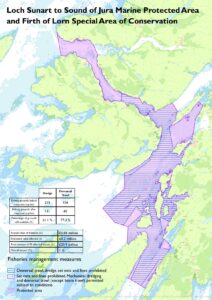Marine
Targeted protection for critically endangered flapper skate proves effective
May 2, 2024 by MS Communications No Comments | Category Endangered species, Fish protection, Marine ecosystem, Marine Protection, Science, Technology, Engineering, Maths_STEM
Over a third of elasmobranchs (cartilaginous fish such as sharks, rays and skates) are categorised as endangered or critically endangered, making them amongst the most threatened marine animals. This includes Dipturus intermedius which is more commonly known as the flapper skate. The decline in flapper skate over the last century is mainly the result of historical overfishing. With their slow body growth, late maturity and an 18-month egg development period, flapper skate are particularly vulnerable to the effects of fishing. Often, individuals were caught before reaching maturity and as a result did not contribute to the next generation, creating the historical decline.
The Loch Sunart to the Sound of Jura Marine Protected Area (MPA) was established in 2014 with fisheries measures, such as fisheries closures and fishing gear restrictions, introduced in 2016. This area is thought to act as an important refuge for flapper skate; being the focus of a joint tagging and survey effort conducted by the Scottish Government’s Marine Directorate, Scottish Association for Marine Science (SAMS) and NatureScot. These evidence-informed MPAs are designated marine spaces which in some instances ban or restrict specific fishing activities to conserve marine resources and ecosystems, supporting climate change adaption and maintaining biodiversity.
The current study looked at how the Loch Sunart to the Sound of Jura MPA helps protect flapper skate. To do so, it used participatory science data collected by the angling community from two areas in the MPA to support the research. Here, participants reported sightings of skate (identified by either tags or photo-identification based on natural markings) logged the location found and noted if they were new to the study or had been found previously in the MPA. From the data, key indicators relating to site based protection, such as survival, residency and movement within and outside of the MPA, and resident population size could be determined.
The study showed a substantial increase in numbers recorded within the two areas of the MPA that anglers visit regularly:
- resident population size increased from 403 to 848 individuals in the Firth of Lorn site between 2016 and 2019
- resident population size increased from 355 to 524 in the Sound of Jura between 2018 and 2019
When compared to the relative stability estimated for the wider west of Scotland area, this observed increase corresponded to an encouraging rise in the number of juvenile flapper skate. Evidence also showed that individuals were very limited in their movement between the Firth of Lorn and the Sound of Jura and that there was little overspill between the MPA and wider area, both observations serving to highlight the importance of the MPA.
This study confirms that when a species shows certain behaviours for example remaining loyal to a site for part or all of its life-cycle, targeted measures to reduce fishing pressures, such as MPAs, can offer vital protection.
This study provides:
- an increased understanding of flapper skate distribution, movement, growth and population dynamics
- evidence that the Loch Sunart to the Sound of Jura MPA is effective at enhancing local flapper skate populations
- evidence that restoration of flapper skate may be realised through the implementation of a network of MPAs
Find out more with the recently published Spatial management measures benefit the critically endangered flapper skate, Dipturus intermedius.
More reading
- Marine Protected Area receives permanent protection for the critically endangered flapper skate
- Marine Permanent protection for flapper skate
- Marine Critically endangered flapper skate study
- Marine Sharks, skates and rays
- Marine Skate Research: Survey in the Loch Sunart to the Sound of Jura MPA
- Marine Engaging the fishing industry in marine environmental survey and monitoring
- Skatespotter by NatureScot
- COSPIDS by Scottish Association for Marine Science, Oban UK
- The Loch Sunart to the Sound of Jura Marine Conservation Order 2016
Tags: Critically Endangered, critically endangered flapper skate, Dipturus intermedius, endangered elasmobranchs, endangered species, Flapper Skate, Flapper Skate Conservation, Loch Sunart to the Sound of Jura, Marine Protected Area, marine protection, MPA, Nature Conservation Marine Protected Area, NatureScot, SAMS, Scotland’s Marine Protected Areas, Scottish Association for Marine Science



Leave a comment